Critical Analysis of Medical Incident: Roy Jacob Case, NUR3201
VerifiedAdded on 2022/10/01
|9
|2571
|52
Report
AI Summary
This report provides a critical analysis of a medical incident, focusing on the case of Mr. Roy Jacob, to examine the importance of communication and accountability in nursing practice. The analysis explores the elements of therapeutic communication, including verbal and non-verbal communication, listening, observation, and building trust, and how their absence contributed to the patient's adverse outcome. It highlights the nurse's responsibility within their scope of practice, emphasizing accountability in decision-making and the application of ethical principles and standards of practice. The report references relevant literature and research studies to support its arguments, and concludes by emphasizing the significance of effective communication and accountability for ensuring quality and safety in nursing care and preventing medical errors. The report also underscores the importance of adherence to professional standards and guidelines, such as the NSQHS Standards, to enhance patient-centered care and improve health outcomes.
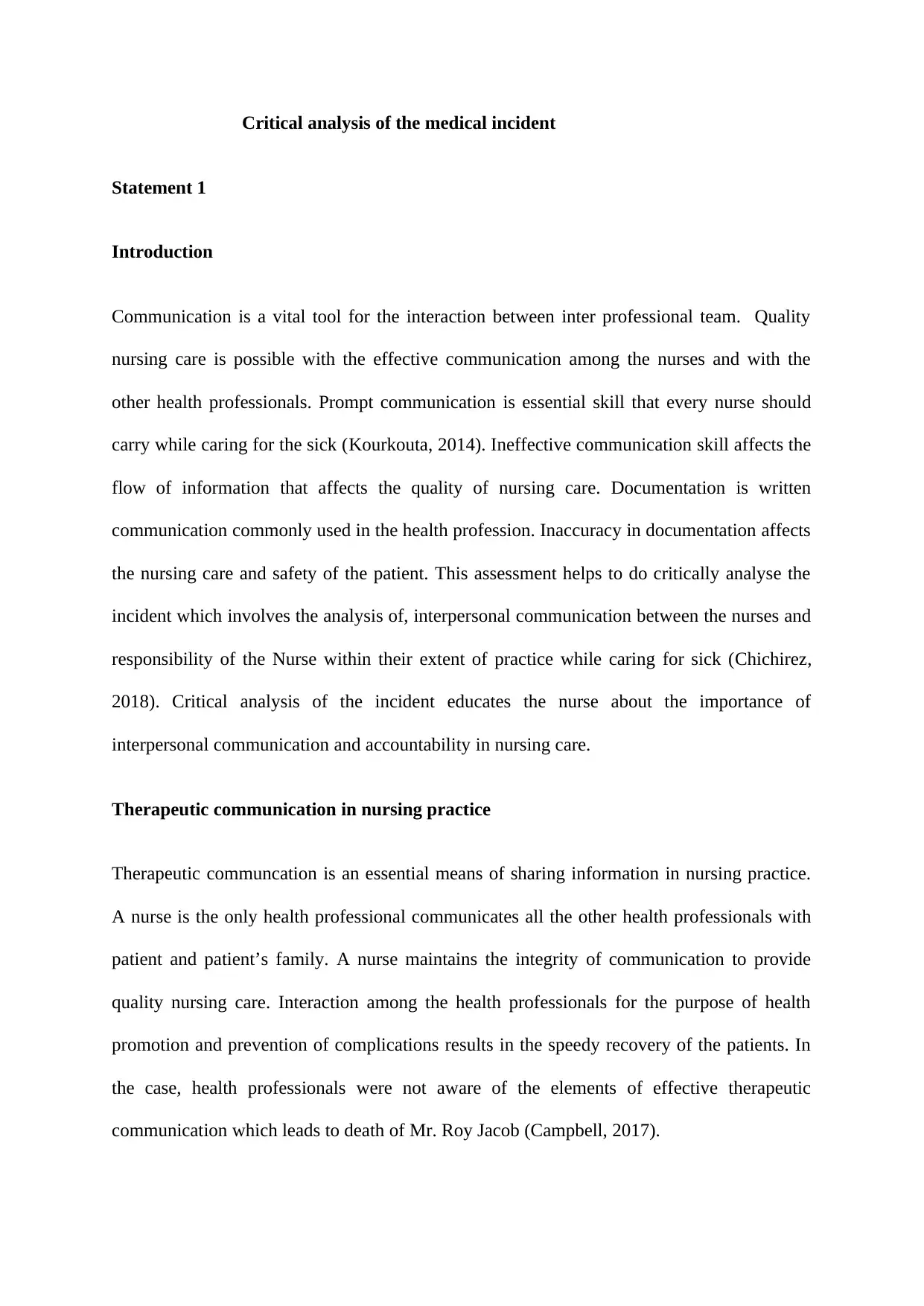
Critical analysis of the medical incident
Statement 1
Introduction
Communication is a vital tool for the interaction between inter professional team. Quality
nursing care is possible with the effective communication among the nurses and with the
other health professionals. Prompt communication is essential skill that every nurse should
carry while caring for the sick (Kourkouta, 2014). Ineffective communication skill affects the
flow of information that affects the quality of nursing care. Documentation is written
communication commonly used in the health profession. Inaccuracy in documentation affects
the nursing care and safety of the patient. This assessment helps to do critically analyse the
incident which involves the analysis of, interpersonal communication between the nurses and
responsibility of the Nurse within their extent of practice while caring for sick (Chichirez,
2018). Critical analysis of the incident educates the nurse about the importance of
interpersonal communication and accountability in nursing care.
Therapeutic communication in nursing practice
Therapeutic communcation is an essential means of sharing information in nursing practice.
A nurse is the only health professional communicates all the other health professionals with
patient and patient’s family. A nurse maintains the integrity of communication to provide
quality nursing care. Interaction among the health professionals for the purpose of health
promotion and prevention of complications results in the speedy recovery of the patients. In
the case, health professionals were not aware of the elements of effective therapeutic
communication which leads to death of Mr. Roy Jacob (Campbell, 2017).
Statement 1
Introduction
Communication is a vital tool for the interaction between inter professional team. Quality
nursing care is possible with the effective communication among the nurses and with the
other health professionals. Prompt communication is essential skill that every nurse should
carry while caring for the sick (Kourkouta, 2014). Ineffective communication skill affects the
flow of information that affects the quality of nursing care. Documentation is written
communication commonly used in the health profession. Inaccuracy in documentation affects
the nursing care and safety of the patient. This assessment helps to do critically analyse the
incident which involves the analysis of, interpersonal communication between the nurses and
responsibility of the Nurse within their extent of practice while caring for sick (Chichirez,
2018). Critical analysis of the incident educates the nurse about the importance of
interpersonal communication and accountability in nursing care.
Therapeutic communication in nursing practice
Therapeutic communcation is an essential means of sharing information in nursing practice.
A nurse is the only health professional communicates all the other health professionals with
patient and patient’s family. A nurse maintains the integrity of communication to provide
quality nursing care. Interaction among the health professionals for the purpose of health
promotion and prevention of complications results in the speedy recovery of the patients. In
the case, health professionals were not aware of the elements of effective therapeutic
communication which leads to death of Mr. Roy Jacob (Campbell, 2017).
Paraphrase This Document
Need a fresh take? Get an instant paraphrase of this document with our AI Paraphraser
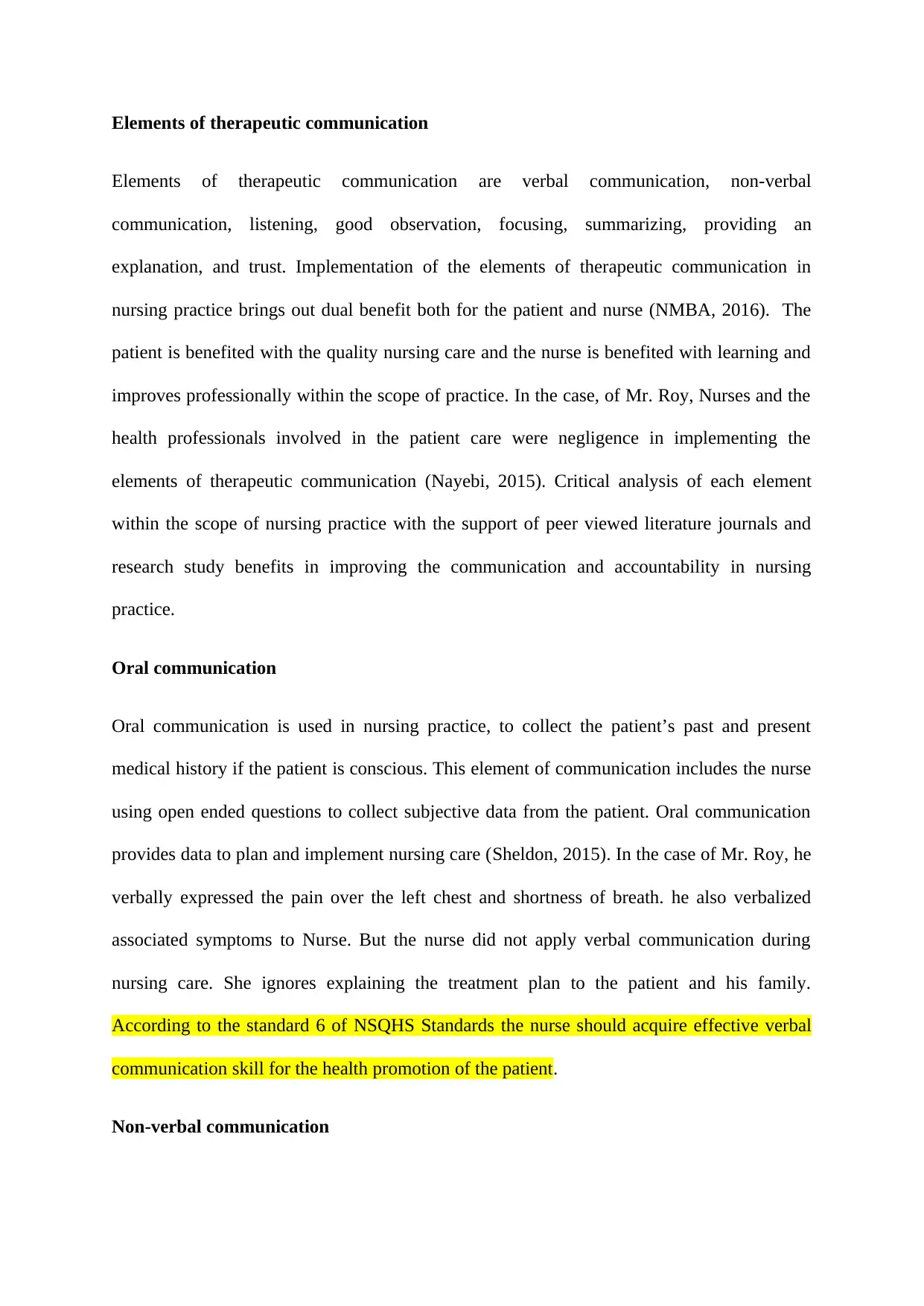
Elements of therapeutic communication
Elements of therapeutic communication are verbal communication, non-verbal
communication, listening, good observation, focusing, summarizing, providing an
explanation, and trust. Implementation of the elements of therapeutic communication in
nursing practice brings out dual benefit both for the patient and nurse (NMBA, 2016). The
patient is benefited with the quality nursing care and the nurse is benefited with learning and
improves professionally within the scope of practice. In the case, of Mr. Roy, Nurses and the
health professionals involved in the patient care were negligence in implementing the
elements of therapeutic communication (Nayebi, 2015). Critical analysis of each element
within the scope of nursing practice with the support of peer viewed literature journals and
research study benefits in improving the communication and accountability in nursing
practice.
Oral communication
Oral communication is used in nursing practice, to collect the patient’s past and present
medical history if the patient is conscious. This element of communication includes the nurse
using open ended questions to collect subjective data from the patient. Oral communication
provides data to plan and implement nursing care (Sheldon, 2015). In the case of Mr. Roy, he
verbally expressed the pain over the left chest and shortness of breath. he also verbalized
associated symptoms to Nurse. But the nurse did not apply verbal communication during
nursing care. She ignores explaining the treatment plan to the patient and his family.
According to the standard 6 of NSQHS Standards the nurse should acquire effective verbal
communication skill for the health promotion of the patient.
Non-verbal communication
Elements of therapeutic communication are verbal communication, non-verbal
communication, listening, good observation, focusing, summarizing, providing an
explanation, and trust. Implementation of the elements of therapeutic communication in
nursing practice brings out dual benefit both for the patient and nurse (NMBA, 2016). The
patient is benefited with the quality nursing care and the nurse is benefited with learning and
improves professionally within the scope of practice. In the case, of Mr. Roy, Nurses and the
health professionals involved in the patient care were negligence in implementing the
elements of therapeutic communication (Nayebi, 2015). Critical analysis of each element
within the scope of nursing practice with the support of peer viewed literature journals and
research study benefits in improving the communication and accountability in nursing
practice.
Oral communication
Oral communication is used in nursing practice, to collect the patient’s past and present
medical history if the patient is conscious. This element of communication includes the nurse
using open ended questions to collect subjective data from the patient. Oral communication
provides data to plan and implement nursing care (Sheldon, 2015). In the case of Mr. Roy, he
verbally expressed the pain over the left chest and shortness of breath. he also verbalized
associated symptoms to Nurse. But the nurse did not apply verbal communication during
nursing care. She ignores explaining the treatment plan to the patient and his family.
According to the standard 6 of NSQHS Standards the nurse should acquire effective verbal
communication skill for the health promotion of the patient.
Non-verbal communication
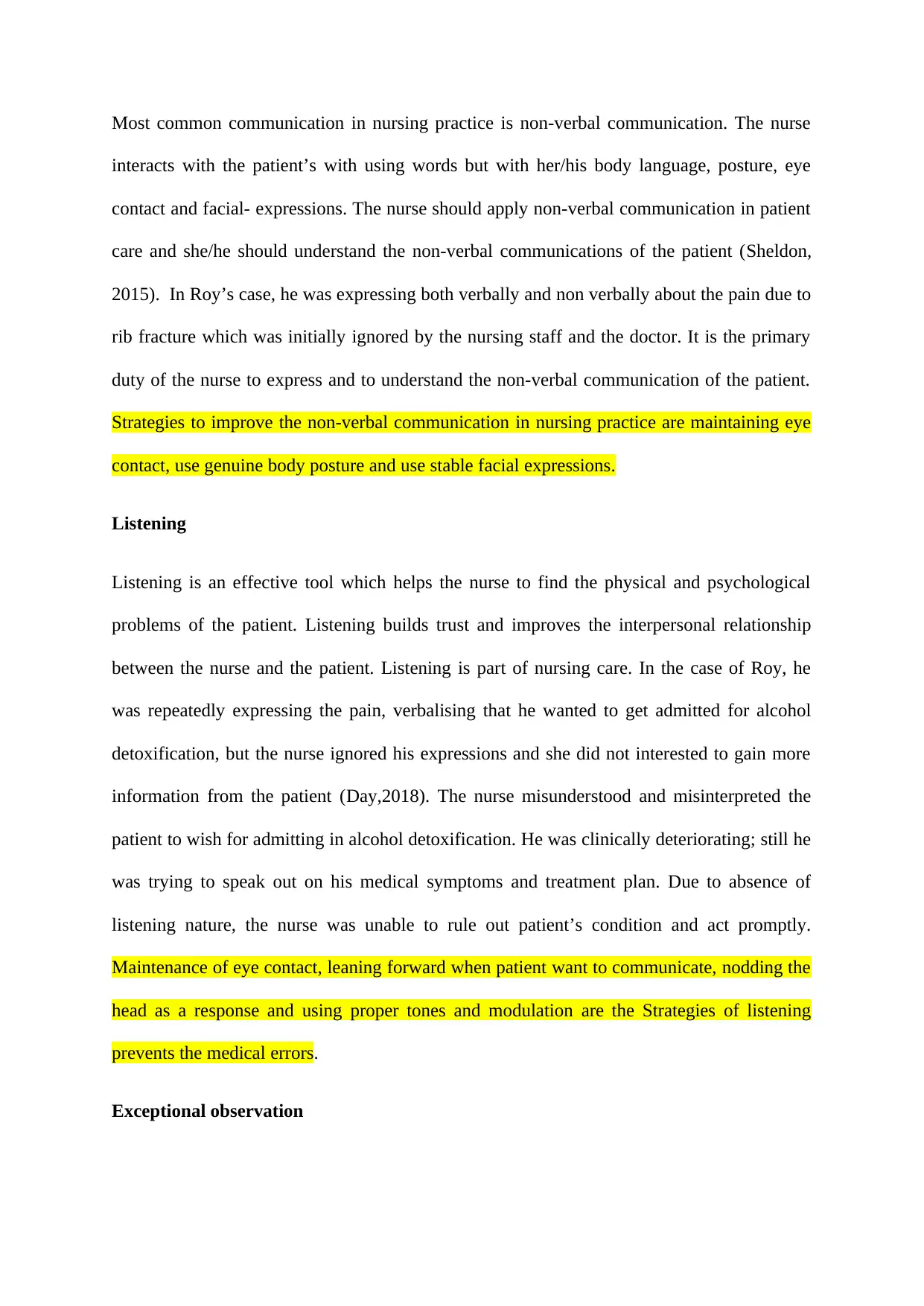
Most common communication in nursing practice is non-verbal communication. The nurse
interacts with the patient’s with using words but with her/his body language, posture, eye
contact and facial- expressions. The nurse should apply non-verbal communication in patient
care and she/he should understand the non-verbal communications of the patient (Sheldon,
2015). In Roy’s case, he was expressing both verbally and non verbally about the pain due to
rib fracture which was initially ignored by the nursing staff and the doctor. It is the primary
duty of the nurse to express and to understand the non-verbal communication of the patient.
Strategies to improve the non-verbal communication in nursing practice are maintaining eye
contact, use genuine body posture and use stable facial expressions.
Listening
Listening is an effective tool which helps the nurse to find the physical and psychological
problems of the patient. Listening builds trust and improves the interpersonal relationship
between the nurse and the patient. Listening is part of nursing care. In the case of Roy, he
was repeatedly expressing the pain, verbalising that he wanted to get admitted for alcohol
detoxification, but the nurse ignored his expressions and she did not interested to gain more
information from the patient (Day,2018). The nurse misunderstood and misinterpreted the
patient to wish for admitting in alcohol detoxification. He was clinically deteriorating; still he
was trying to speak out on his medical symptoms and treatment plan. Due to absence of
listening nature, the nurse was unable to rule out patient’s condition and act promptly.
Maintenance of eye contact, leaning forward when patient want to communicate, nodding the
head as a response and using proper tones and modulation are the Strategies of listening
prevents the medical errors.
Exceptional observation
interacts with the patient’s with using words but with her/his body language, posture, eye
contact and facial- expressions. The nurse should apply non-verbal communication in patient
care and she/he should understand the non-verbal communications of the patient (Sheldon,
2015). In Roy’s case, he was expressing both verbally and non verbally about the pain due to
rib fracture which was initially ignored by the nursing staff and the doctor. It is the primary
duty of the nurse to express and to understand the non-verbal communication of the patient.
Strategies to improve the non-verbal communication in nursing practice are maintaining eye
contact, use genuine body posture and use stable facial expressions.
Listening
Listening is an effective tool which helps the nurse to find the physical and psychological
problems of the patient. Listening builds trust and improves the interpersonal relationship
between the nurse and the patient. Listening is part of nursing care. In the case of Roy, he
was repeatedly expressing the pain, verbalising that he wanted to get admitted for alcohol
detoxification, but the nurse ignored his expressions and she did not interested to gain more
information from the patient (Day,2018). The nurse misunderstood and misinterpreted the
patient to wish for admitting in alcohol detoxification. He was clinically deteriorating; still he
was trying to speak out on his medical symptoms and treatment plan. Due to absence of
listening nature, the nurse was unable to rule out patient’s condition and act promptly.
Maintenance of eye contact, leaning forward when patient want to communicate, nodding the
head as a response and using proper tones and modulation are the Strategies of listening
prevents the medical errors.
Exceptional observation
⊘ This is a preview!⊘
Do you want full access?
Subscribe today to unlock all pages.

Trusted by 1+ million students worldwide
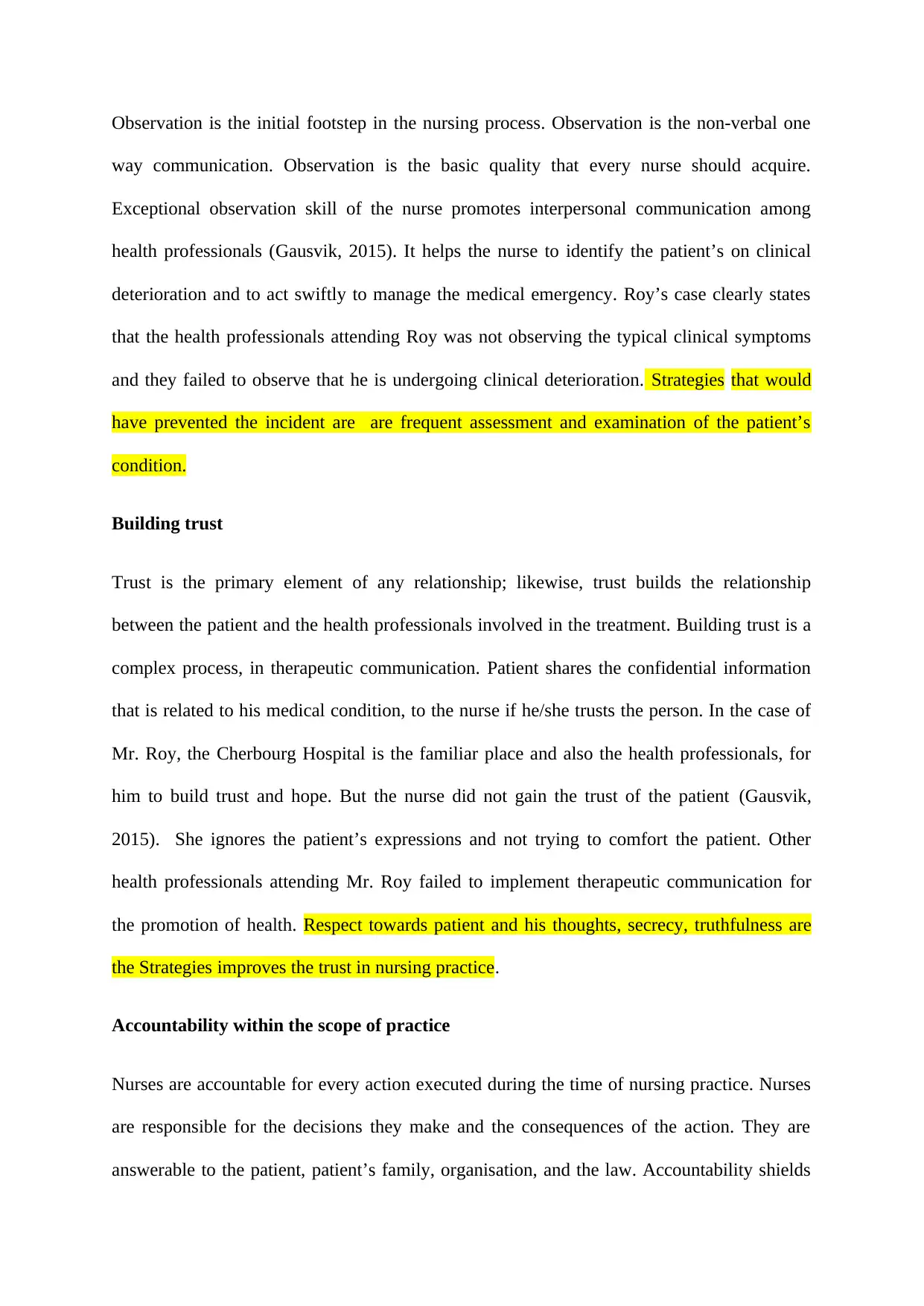
Observation is the initial footstep in the nursing process. Observation is the non-verbal one
way communication. Observation is the basic quality that every nurse should acquire.
Exceptional observation skill of the nurse promotes interpersonal communication among
health professionals (Gausvik, 2015). It helps the nurse to identify the patient’s on clinical
deterioration and to act swiftly to manage the medical emergency. Roy’s case clearly states
that the health professionals attending Roy was not observing the typical clinical symptoms
and they failed to observe that he is undergoing clinical deterioration. Strategies that would
have prevented the incident are are frequent assessment and examination of the patient’s
condition.
Building trust
Trust is the primary element of any relationship; likewise, trust builds the relationship
between the patient and the health professionals involved in the treatment. Building trust is a
complex process, in therapeutic communication. Patient shares the confidential information
that is related to his medical condition, to the nurse if he/she trusts the person. In the case of
Mr. Roy, the Cherbourg Hospital is the familiar place and also the health professionals, for
him to build trust and hope. But the nurse did not gain the trust of the patient (Gausvik,
2015). She ignores the patient’s expressions and not trying to comfort the patient. Other
health professionals attending Mr. Roy failed to implement therapeutic communication for
the promotion of health. Respect towards patient and his thoughts, secrecy, truthfulness are
the Strategies improves the trust in nursing practice.
Accountability within the scope of practice
Nurses are accountable for every action executed during the time of nursing practice. Nurses
are responsible for the decisions they make and the consequences of the action. They are
answerable to the patient, patient’s family, organisation, and the law. Accountability shields
way communication. Observation is the basic quality that every nurse should acquire.
Exceptional observation skill of the nurse promotes interpersonal communication among
health professionals (Gausvik, 2015). It helps the nurse to identify the patient’s on clinical
deterioration and to act swiftly to manage the medical emergency. Roy’s case clearly states
that the health professionals attending Roy was not observing the typical clinical symptoms
and they failed to observe that he is undergoing clinical deterioration. Strategies that would
have prevented the incident are are frequent assessment and examination of the patient’s
condition.
Building trust
Trust is the primary element of any relationship; likewise, trust builds the relationship
between the patient and the health professionals involved in the treatment. Building trust is a
complex process, in therapeutic communication. Patient shares the confidential information
that is related to his medical condition, to the nurse if he/she trusts the person. In the case of
Mr. Roy, the Cherbourg Hospital is the familiar place and also the health professionals, for
him to build trust and hope. But the nurse did not gain the trust of the patient (Gausvik,
2015). She ignores the patient’s expressions and not trying to comfort the patient. Other
health professionals attending Mr. Roy failed to implement therapeutic communication for
the promotion of health. Respect towards patient and his thoughts, secrecy, truthfulness are
the Strategies improves the trust in nursing practice.
Accountability within the scope of practice
Nurses are accountable for every action executed during the time of nursing practice. Nurses
are responsible for the decisions they make and the consequences of the action. They are
answerable to the patient, patient’s family, organisation, and the law. Accountability shields
Paraphrase This Document
Need a fresh take? Get an instant paraphrase of this document with our AI Paraphraser
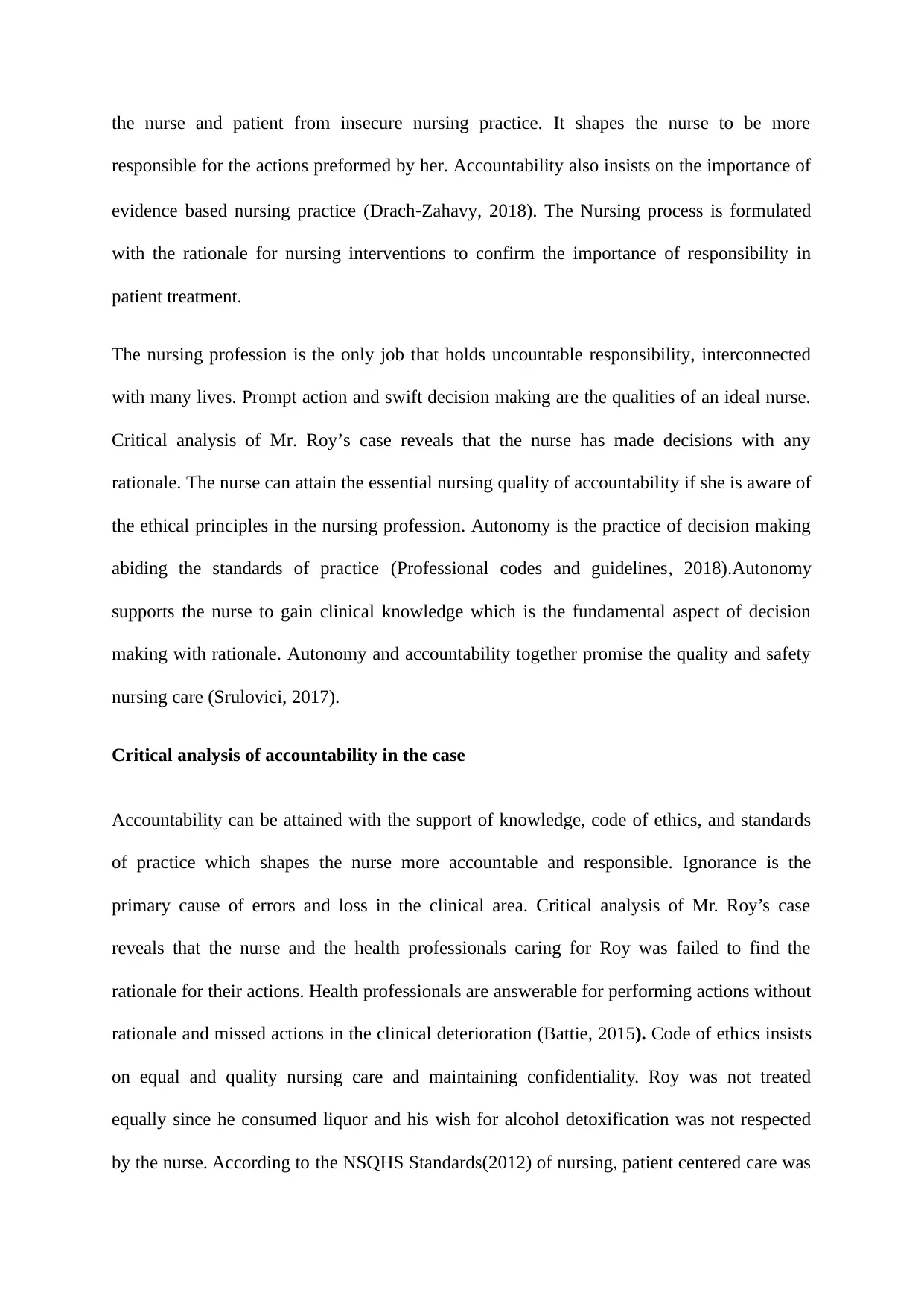
the nurse and patient from insecure nursing practice. It shapes the nurse to be more
responsible for the actions preformed by her. Accountability also insists on the importance of
evidence based nursing practice (Drach‐Zahavy, 2018). The Nursing process is formulated
with the rationale for nursing interventions to confirm the importance of responsibility in
patient treatment.
The nursing profession is the only job that holds uncountable responsibility, interconnected
with many lives. Prompt action and swift decision making are the qualities of an ideal nurse.
Critical analysis of Mr. Roy’s case reveals that the nurse has made decisions with any
rationale. The nurse can attain the essential nursing quality of accountability if she is aware of
the ethical principles in the nursing profession. Autonomy is the practice of decision making
abiding the standards of practice (Professional codes and guidelines, 2018).Autonomy
supports the nurse to gain clinical knowledge which is the fundamental aspect of decision
making with rationale. Autonomy and accountability together promise the quality and safety
nursing care (Srulovici, 2017).
Critical analysis of accountability in the case
Accountability can be attained with the support of knowledge, code of ethics, and standards
of practice which shapes the nurse more accountable and responsible. Ignorance is the
primary cause of errors and loss in the clinical area. Critical analysis of Mr. Roy’s case
reveals that the nurse and the health professionals caring for Roy was failed to find the
rationale for their actions. Health professionals are answerable for performing actions without
rationale and missed actions in the clinical deterioration (Battie, 2015). Code of ethics insists
on equal and quality nursing care and maintaining confidentiality. Roy was not treated
equally since he consumed liquor and his wish for alcohol detoxification was not respected
by the nurse. According to the NSQHS Standards(2012) of nursing, patient centered care was
responsible for the actions preformed by her. Accountability also insists on the importance of
evidence based nursing practice (Drach‐Zahavy, 2018). The Nursing process is formulated
with the rationale for nursing interventions to confirm the importance of responsibility in
patient treatment.
The nursing profession is the only job that holds uncountable responsibility, interconnected
with many lives. Prompt action and swift decision making are the qualities of an ideal nurse.
Critical analysis of Mr. Roy’s case reveals that the nurse has made decisions with any
rationale. The nurse can attain the essential nursing quality of accountability if she is aware of
the ethical principles in the nursing profession. Autonomy is the practice of decision making
abiding the standards of practice (Professional codes and guidelines, 2018).Autonomy
supports the nurse to gain clinical knowledge which is the fundamental aspect of decision
making with rationale. Autonomy and accountability together promise the quality and safety
nursing care (Srulovici, 2017).
Critical analysis of accountability in the case
Accountability can be attained with the support of knowledge, code of ethics, and standards
of practice which shapes the nurse more accountable and responsible. Ignorance is the
primary cause of errors and loss in the clinical area. Critical analysis of Mr. Roy’s case
reveals that the nurse and the health professionals caring for Roy was failed to find the
rationale for their actions. Health professionals are answerable for performing actions without
rationale and missed actions in the clinical deterioration (Battie, 2015). Code of ethics insists
on equal and quality nursing care and maintaining confidentiality. Roy was not treated
equally since he consumed liquor and his wish for alcohol detoxification was not respected
by the nurse. According to the NSQHS Standards(2012) of nursing, patient centered care was
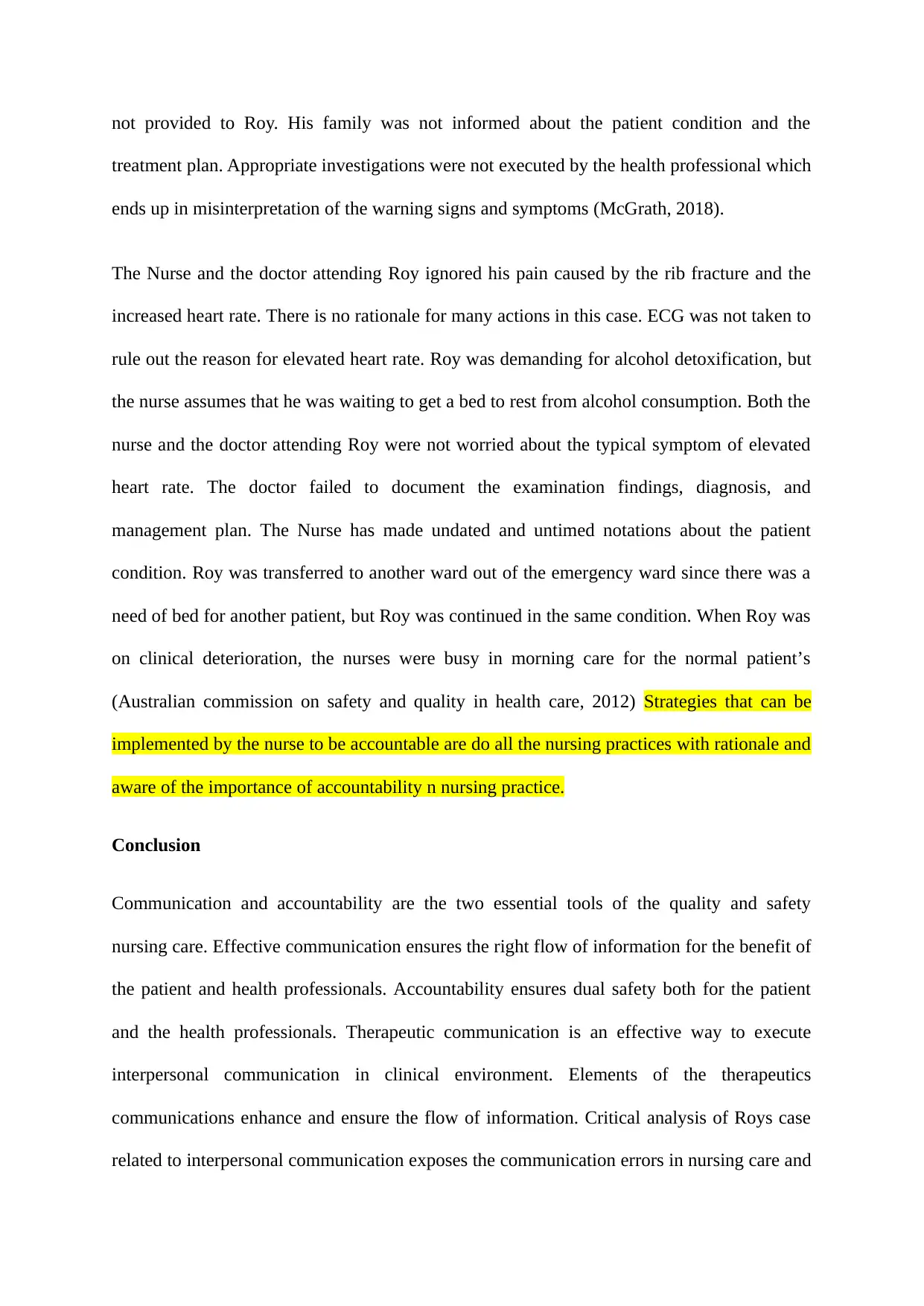
not provided to Roy. His family was not informed about the patient condition and the
treatment plan. Appropriate investigations were not executed by the health professional which
ends up in misinterpretation of the warning signs and symptoms (McGrath, 2018).
The Nurse and the doctor attending Roy ignored his pain caused by the rib fracture and the
increased heart rate. There is no rationale for many actions in this case. ECG was not taken to
rule out the reason for elevated heart rate. Roy was demanding for alcohol detoxification, but
the nurse assumes that he was waiting to get a bed to rest from alcohol consumption. Both the
nurse and the doctor attending Roy were not worried about the typical symptom of elevated
heart rate. The doctor failed to document the examination findings, diagnosis, and
management plan. The Nurse has made undated and untimed notations about the patient
condition. Roy was transferred to another ward out of the emergency ward since there was a
need of bed for another patient, but Roy was continued in the same condition. When Roy was
on clinical deterioration, the nurses were busy in morning care for the normal patient’s
(Australian commission on safety and quality in health care, 2012) Strategies that can be
implemented by the nurse to be accountable are do all the nursing practices with rationale and
aware of the importance of accountability n nursing practice.
Conclusion
Communication and accountability are the two essential tools of the quality and safety
nursing care. Effective communication ensures the right flow of information for the benefit of
the patient and health professionals. Accountability ensures dual safety both for the patient
and the health professionals. Therapeutic communication is an effective way to execute
interpersonal communication in clinical environment. Elements of the therapeutics
communications enhance and ensure the flow of information. Critical analysis of Roys case
related to interpersonal communication exposes the communication errors in nursing care and
treatment plan. Appropriate investigations were not executed by the health professional which
ends up in misinterpretation of the warning signs and symptoms (McGrath, 2018).
The Nurse and the doctor attending Roy ignored his pain caused by the rib fracture and the
increased heart rate. There is no rationale for many actions in this case. ECG was not taken to
rule out the reason for elevated heart rate. Roy was demanding for alcohol detoxification, but
the nurse assumes that he was waiting to get a bed to rest from alcohol consumption. Both the
nurse and the doctor attending Roy were not worried about the typical symptom of elevated
heart rate. The doctor failed to document the examination findings, diagnosis, and
management plan. The Nurse has made undated and untimed notations about the patient
condition. Roy was transferred to another ward out of the emergency ward since there was a
need of bed for another patient, but Roy was continued in the same condition. When Roy was
on clinical deterioration, the nurses were busy in morning care for the normal patient’s
(Australian commission on safety and quality in health care, 2012) Strategies that can be
implemented by the nurse to be accountable are do all the nursing practices with rationale and
aware of the importance of accountability n nursing practice.
Conclusion
Communication and accountability are the two essential tools of the quality and safety
nursing care. Effective communication ensures the right flow of information for the benefit of
the patient and health professionals. Accountability ensures dual safety both for the patient
and the health professionals. Therapeutic communication is an effective way to execute
interpersonal communication in clinical environment. Elements of the therapeutics
communications enhance and ensure the flow of information. Critical analysis of Roys case
related to interpersonal communication exposes the communication errors in nursing care and
⊘ This is a preview!⊘
Do you want full access?
Subscribe today to unlock all pages.

Trusted by 1+ million students worldwide
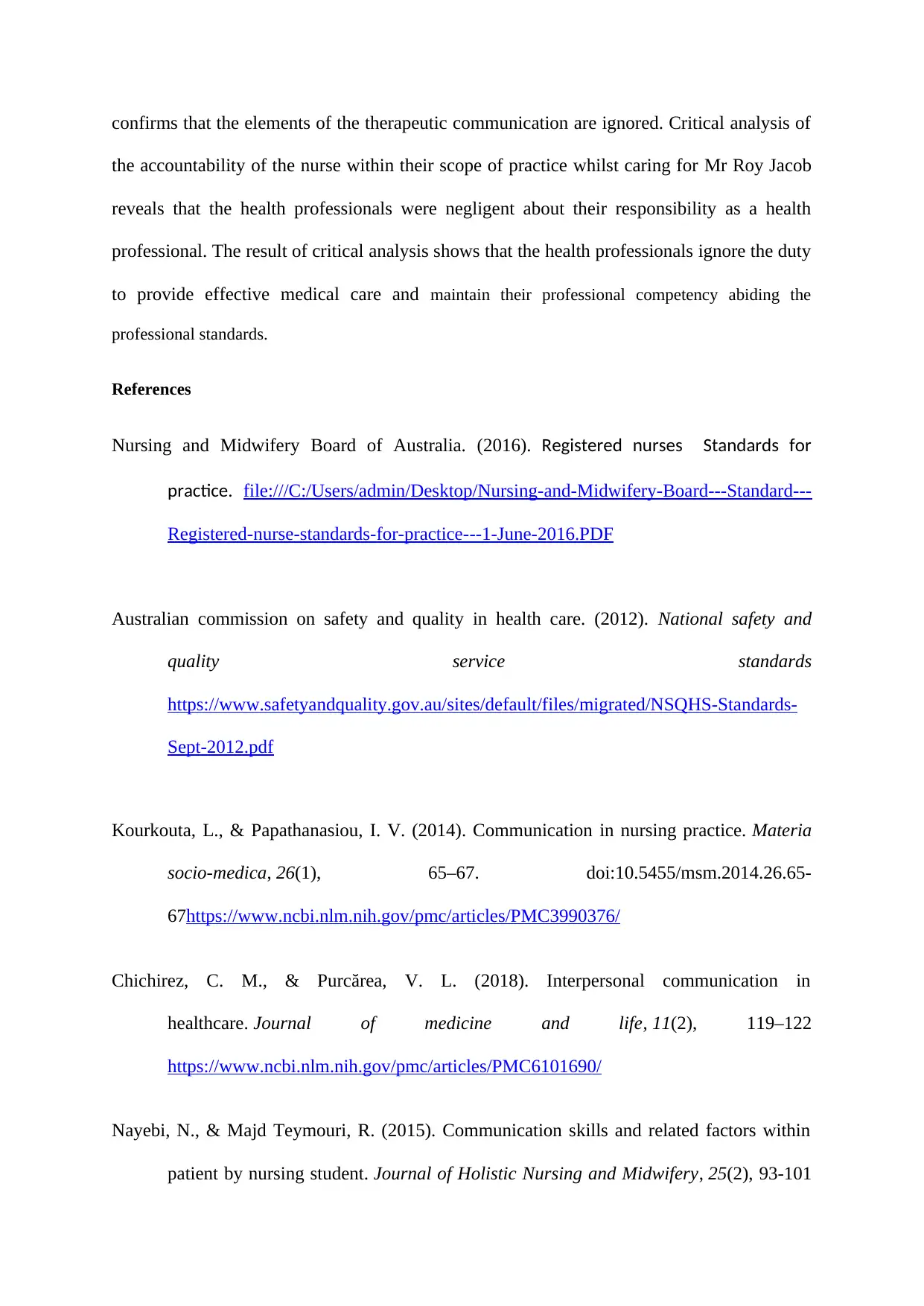
confirms that the elements of the therapeutic communication are ignored. Critical analysis of
the accountability of the nurse within their scope of practice whilst caring for Mr Roy Jacob
reveals that the health professionals were negligent about their responsibility as a health
professional. The result of critical analysis shows that the health professionals ignore the duty
to provide effective medical care and maintain their professional competency abiding the
professional standards.
References
Nursing and Midwifery Board of Australia. (2016). Registered nurses Standards for
practice. file:///C:/Users/admin/Desktop/Nursing-and-Midwifery-Board---Standard---
Registered-nurse-standards-for-practice---1-June-2016.PDF
Australian commission on safety and quality in health care. (2012). National safety and
quality service standards
https://www.safetyandquality.gov.au/sites/default/files/migrated/NSQHS-Standards-
Sept-2012.pdf
Kourkouta, L., & Papathanasiou, I. V. (2014). Communication in nursing practice. Materia
socio-medica, 26(1), 65–67. doi:10.5455/msm.2014.26.65-
67https://www.ncbi.nlm.nih.gov/pmc/articles/PMC3990376/
Chichirez, C. M., & Purcărea, V. L. (2018). Interpersonal communication in
healthcare. Journal of medicine and life, 11(2), 119–122
https://www.ncbi.nlm.nih.gov/pmc/articles/PMC6101690/
Nayebi, N., & Majd Teymouri, R. (2015). Communication skills and related factors within
patient by nursing student. Journal of Holistic Nursing and Midwifery, 25(2), 93-101
the accountability of the nurse within their scope of practice whilst caring for Mr Roy Jacob
reveals that the health professionals were negligent about their responsibility as a health
professional. The result of critical analysis shows that the health professionals ignore the duty
to provide effective medical care and maintain their professional competency abiding the
professional standards.
References
Nursing and Midwifery Board of Australia. (2016). Registered nurses Standards for
practice. file:///C:/Users/admin/Desktop/Nursing-and-Midwifery-Board---Standard---
Registered-nurse-standards-for-practice---1-June-2016.PDF
Australian commission on safety and quality in health care. (2012). National safety and
quality service standards
https://www.safetyandquality.gov.au/sites/default/files/migrated/NSQHS-Standards-
Sept-2012.pdf
Kourkouta, L., & Papathanasiou, I. V. (2014). Communication in nursing practice. Materia
socio-medica, 26(1), 65–67. doi:10.5455/msm.2014.26.65-
67https://www.ncbi.nlm.nih.gov/pmc/articles/PMC3990376/
Chichirez, C. M., & Purcărea, V. L. (2018). Interpersonal communication in
healthcare. Journal of medicine and life, 11(2), 119–122
https://www.ncbi.nlm.nih.gov/pmc/articles/PMC6101690/
Nayebi, N., & Majd Teymouri, R. (2015). Communication skills and related factors within
patient by nursing student. Journal of Holistic Nursing and Midwifery, 25(2), 93-101
Paraphrase This Document
Need a fresh take? Get an instant paraphrase of this document with our AI Paraphraser
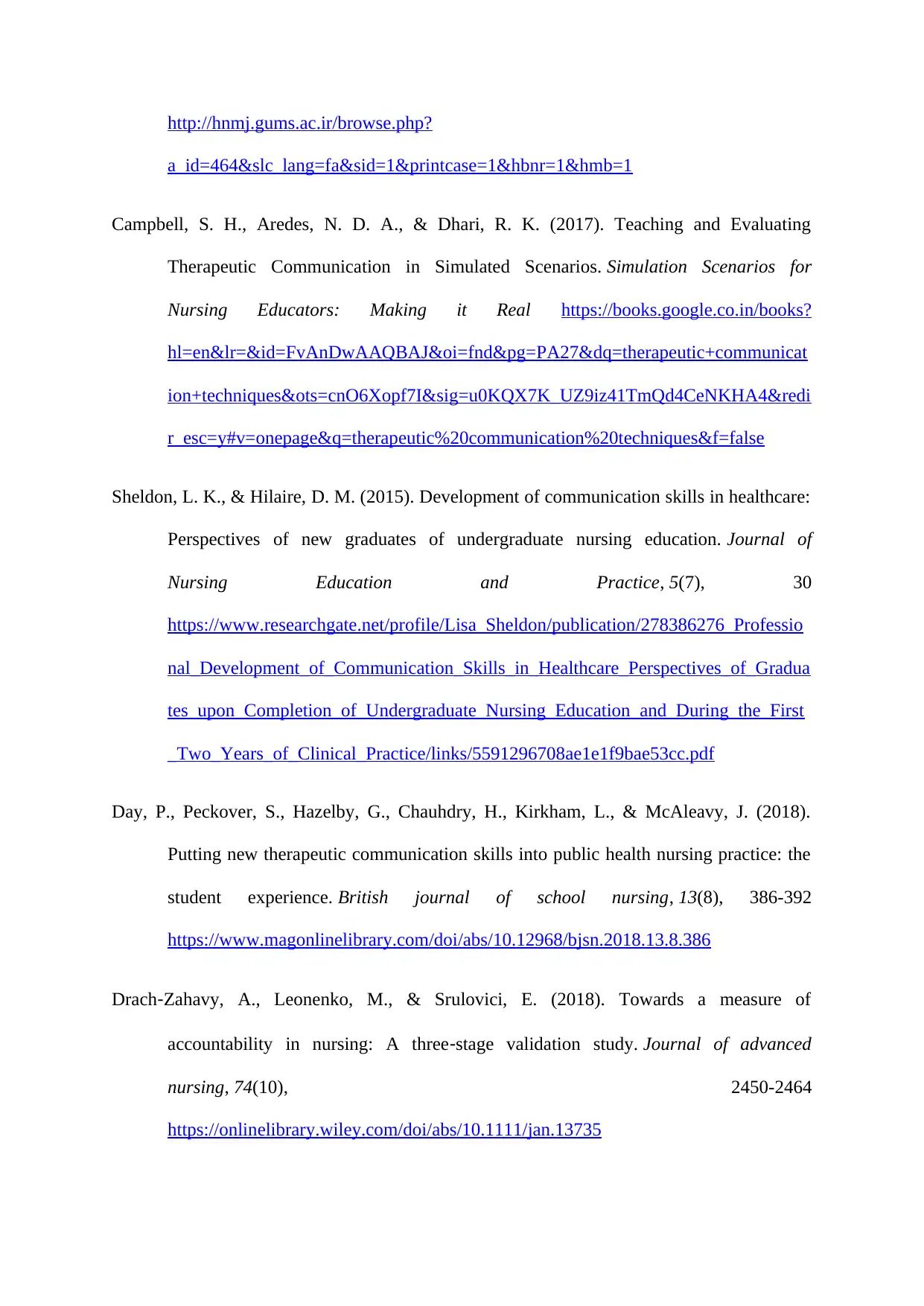
http://hnmj.gums.ac.ir/browse.php?
a_id=464&slc_lang=fa&sid=1&printcase=1&hbnr=1&hmb=1
Campbell, S. H., Aredes, N. D. A., & Dhari, R. K. (2017). Teaching and Evaluating
Therapeutic Communication in Simulated Scenarios. Simulation Scenarios for
Nursing Educators: Making it Real https://books.google.co.in/books?
hl=en&lr=&id=FvAnDwAAQBAJ&oi=fnd&pg=PA27&dq=therapeutic+communicat
ion+techniques&ots=cnO6Xopf7I&sig=u0KQX7K_UZ9iz41TmQd4CeNKHA4&redi
r_esc=y#v=onepage&q=therapeutic%20communication%20techniques&f=false
Sheldon, L. K., & Hilaire, D. M. (2015). Development of communication skills in healthcare:
Perspectives of new graduates of undergraduate nursing education. Journal of
Nursing Education and Practice, 5(7), 30
https://www.researchgate.net/profile/Lisa_Sheldon/publication/278386276_Professio
nal_Development_of_Communication_Skills_in_Healthcare_Perspectives_of_Gradua
tes_upon_Completion_of_Undergraduate_Nursing_Education_and_During_the_First
_Two_Years_of_Clinical_Practice/links/5591296708ae1e1f9bae53cc.pdf
Day, P., Peckover, S., Hazelby, G., Chauhdry, H., Kirkham, L., & McAleavy, J. (2018).
Putting new therapeutic communication skills into public health nursing practice: the
student experience. British journal of school nursing, 13(8), 386-392
https://www.magonlinelibrary.com/doi/abs/10.12968/bjsn.2018.13.8.386
Drach‐Zahavy, A., Leonenko, M., & Srulovici, E. (2018). Towards a measure of
accountability in nursing: A three‐stage validation study. Journal of advanced
nursing, 74(10), 2450-2464
https://onlinelibrary.wiley.com/doi/abs/10.1111/jan.13735
a_id=464&slc_lang=fa&sid=1&printcase=1&hbnr=1&hmb=1
Campbell, S. H., Aredes, N. D. A., & Dhari, R. K. (2017). Teaching and Evaluating
Therapeutic Communication in Simulated Scenarios. Simulation Scenarios for
Nursing Educators: Making it Real https://books.google.co.in/books?
hl=en&lr=&id=FvAnDwAAQBAJ&oi=fnd&pg=PA27&dq=therapeutic+communicat
ion+techniques&ots=cnO6Xopf7I&sig=u0KQX7K_UZ9iz41TmQd4CeNKHA4&redi
r_esc=y#v=onepage&q=therapeutic%20communication%20techniques&f=false
Sheldon, L. K., & Hilaire, D. M. (2015). Development of communication skills in healthcare:
Perspectives of new graduates of undergraduate nursing education. Journal of
Nursing Education and Practice, 5(7), 30
https://www.researchgate.net/profile/Lisa_Sheldon/publication/278386276_Professio
nal_Development_of_Communication_Skills_in_Healthcare_Perspectives_of_Gradua
tes_upon_Completion_of_Undergraduate_Nursing_Education_and_During_the_First
_Two_Years_of_Clinical_Practice/links/5591296708ae1e1f9bae53cc.pdf
Day, P., Peckover, S., Hazelby, G., Chauhdry, H., Kirkham, L., & McAleavy, J. (2018).
Putting new therapeutic communication skills into public health nursing practice: the
student experience. British journal of school nursing, 13(8), 386-392
https://www.magonlinelibrary.com/doi/abs/10.12968/bjsn.2018.13.8.386
Drach‐Zahavy, A., Leonenko, M., & Srulovici, E. (2018). Towards a measure of
accountability in nursing: A three‐stage validation study. Journal of advanced
nursing, 74(10), 2450-2464
https://onlinelibrary.wiley.com/doi/abs/10.1111/jan.13735
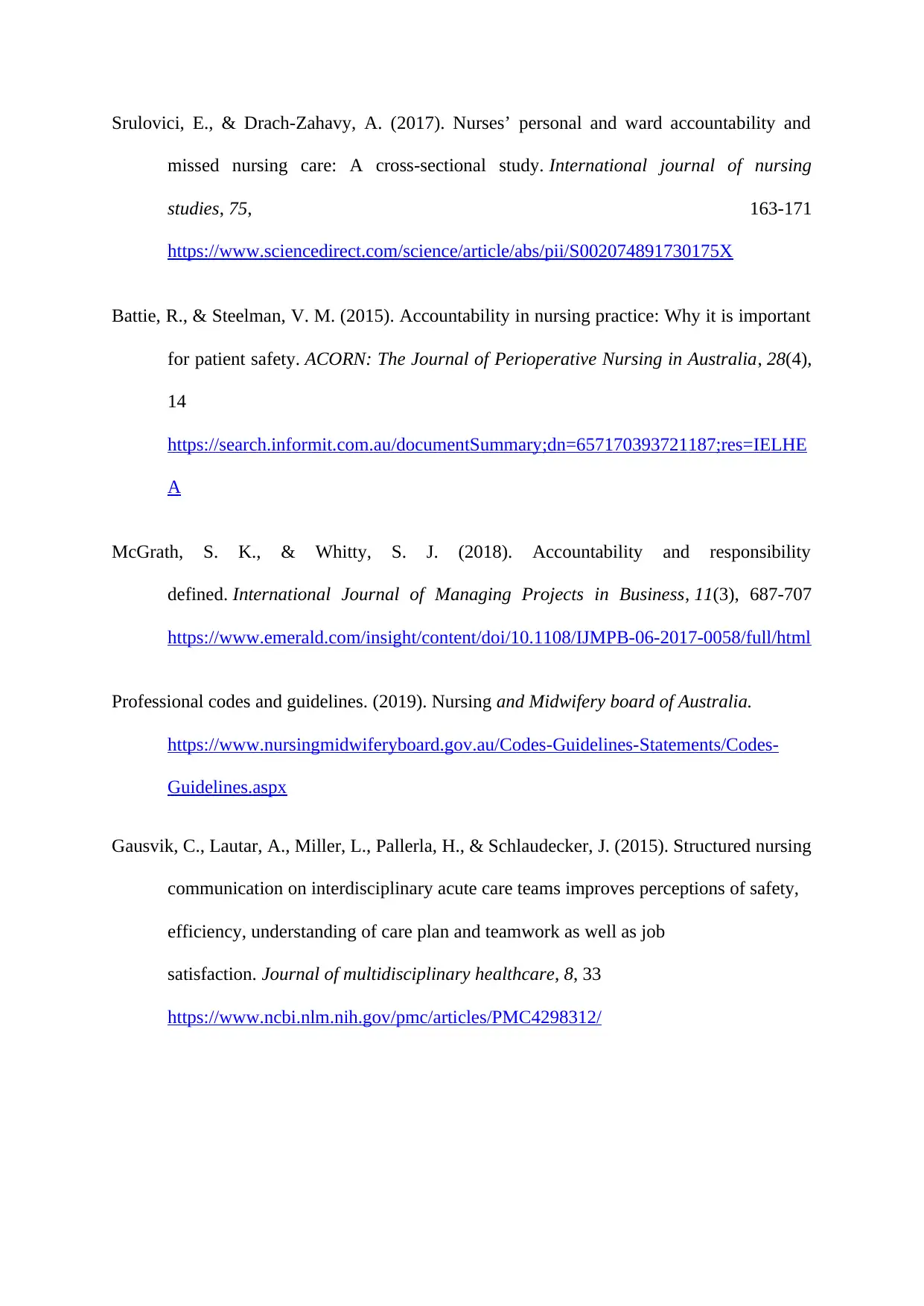
Srulovici, E., & Drach-Zahavy, A. (2017). Nurses’ personal and ward accountability and
missed nursing care: A cross-sectional study. International journal of nursing
studies, 75, 163-171
https://www.sciencedirect.com/science/article/abs/pii/S002074891730175X
Battie, R., & Steelman, V. M. (2015). Accountability in nursing practice: Why it is important
for patient safety. ACORN: The Journal of Perioperative Nursing in Australia, 28(4),
14
https://search.informit.com.au/documentSummary;dn=657170393721187;res=IELHE
A
McGrath, S. K., & Whitty, S. J. (2018). Accountability and responsibility
defined. International Journal of Managing Projects in Business, 11(3), 687-707
https://www.emerald.com/insight/content/doi/10.1108/IJMPB-06-2017-0058/full/html
Professional codes and guidelines. (2019). Nursing and Midwifery board of Australia.
https://www.nursingmidwiferyboard.gov.au/Codes-Guidelines-Statements/Codes-
Guidelines.aspx
Gausvik, C., Lautar, A., Miller, L., Pallerla, H., & Schlaudecker, J. (2015). Structured nursing
communication on interdisciplinary acute care teams improves perceptions of safety,
efficiency, understanding of care plan and teamwork as well as job
satisfaction. Journal of multidisciplinary healthcare, 8, 33
https://www.ncbi.nlm.nih.gov/pmc/articles/PMC4298312/
missed nursing care: A cross-sectional study. International journal of nursing
studies, 75, 163-171
https://www.sciencedirect.com/science/article/abs/pii/S002074891730175X
Battie, R., & Steelman, V. M. (2015). Accountability in nursing practice: Why it is important
for patient safety. ACORN: The Journal of Perioperative Nursing in Australia, 28(4),
14
https://search.informit.com.au/documentSummary;dn=657170393721187;res=IELHE
A
McGrath, S. K., & Whitty, S. J. (2018). Accountability and responsibility
defined. International Journal of Managing Projects in Business, 11(3), 687-707
https://www.emerald.com/insight/content/doi/10.1108/IJMPB-06-2017-0058/full/html
Professional codes and guidelines. (2019). Nursing and Midwifery board of Australia.
https://www.nursingmidwiferyboard.gov.au/Codes-Guidelines-Statements/Codes-
Guidelines.aspx
Gausvik, C., Lautar, A., Miller, L., Pallerla, H., & Schlaudecker, J. (2015). Structured nursing
communication on interdisciplinary acute care teams improves perceptions of safety,
efficiency, understanding of care plan and teamwork as well as job
satisfaction. Journal of multidisciplinary healthcare, 8, 33
https://www.ncbi.nlm.nih.gov/pmc/articles/PMC4298312/
⊘ This is a preview!⊘
Do you want full access?
Subscribe today to unlock all pages.

Trusted by 1+ million students worldwide
1 out of 9
Related Documents
Your All-in-One AI-Powered Toolkit for Academic Success.
+13062052269
info@desklib.com
Available 24*7 on WhatsApp / Email
![[object Object]](/_next/static/media/star-bottom.7253800d.svg)
Unlock your academic potential
Copyright © 2020–2025 A2Z Services. All Rights Reserved. Developed and managed by ZUCOL.





